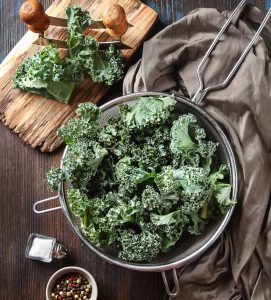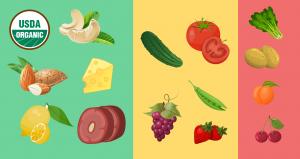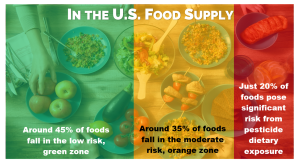“Hot Potatoes” — Which Foods, Where From, Grown How, Pose the Highest Risks?
The Dietary Risk Index system provides, for the first time, a way to determine where a variety of foods land along the dietary risk continuum.
DRI values gradually rise along the dietary risk continuum from the lower-risk, left one-half (shown in green below) of the continuum, and incrementally rise to the right (in red) along the continuum.
It is helpful to assess where various foods, or individual samples of food, lie along the continuum, based on their DRI values.
In addition, the dietary risk continuum can be divided into various zones, ranging from generally low risk levels to progressively higher risks. For example —
- Significant Risk Zone,
- Modest to Moderate Risk Zone, and
- Low to Zero Risk Zone
Identifying Hot Potato Foods
“Hot Potato” foods, and individual samples of food, can be identified via the DRI system. They are “hot” because they pose risks near to, or above EPA’s “level of concern.”
For nearly all foods, the highest risk samples pose risks several-fold higher than the average positive sample, and 100-fold or more higher than the average DRI across samples in the “Low to Zero Risk” zone.

Take for example the distribution of residue levels in the highly nutritious leafy green kale.
In 2017 and 2018, the US-PDP tested 1,108 samples of domestic, conventional kale that contained one of more residues.
The average DRI across the five hottest of the “hot potato” kale samples was a worrisome 9.0. Four of these 5 samples were grown in California, and the source of the fifth was listed by the PDP as “unknown.”
The average DRI among the cleanest 100 samples of kale — almost 10% of the total 1,107 samples — was 0.00014, a very very low level of risk.
Accordingly, the top-five riskiest samples posed average DRI risk values almost 63,700-times higher than the average DRI across the cleanest 10% of samples!!
The cleanest 550 samples of kale — about one-half of the 1,107 tested — collectively accounted for less than 6% of total DRI risk across all samples.
Returning to the dietary risk continuum, 67 samples of kale (6% of all samples) had a DRI value greater than 1, and hence belong in the “Significant Risk” zone based on aggregate risk across all pesticides in each of these 67 samples.
The “Low to Zero Risk” zone contains 645 samples of kale, or 58.3% of the total. All of these samples had a DRI less than 0.1.
The “Modest to Moderate Risk” zone contained the other 35.7% of kale samples (395 samples). The DRI for these samples ranged between 0.1 and 1.0.
DRI results for the full list of 1,108 domestic, conventional kale samples tested by the US PDP is here.
Why Does the Distribution of Residues and DRI Values Matter?

For once, an important question with two easy answers.
First, the distribution of food-specific DRI values across all the samples tested in a given year is typically highly skewed, with relatively few really high-risk samples, and a much larger number and percent of samples in the “Low to Zero Risk” zone.
Second, pesticide dietary risks can be dramatically and continuously reduced by identifying those regions and farming systems producing high-risk samples.
Then, knowing where high-risk samples are coming from, all the players along the value chain can work together to encourage adoption of the farming and pest management systems relied upon by the bulk of growers producing food falling comfortably in the “Low to No Risk” zone.
As fields once producing “Significant Risk” crops make progress in reducing reliance on high-risk pesticides, overall dietary risks will fall. And that is progress everyone should applaud — and support.

